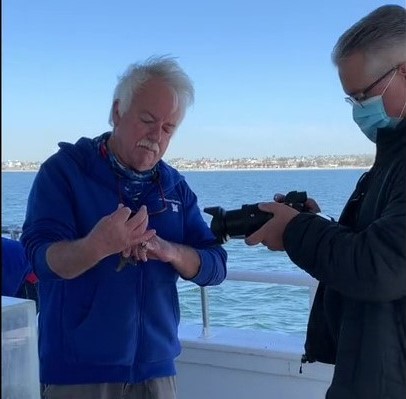Virtual Field Trips
If a trip on the Marine Science Floating Lab is not possible, students can still explore the world of the ocean with our Virtual Field Trips. Without leaving the classroom, students can see what lives in the ocean and discover why it is important for all of us to take care of the marine environment.
Each Virtual Field Trip focuses on one of the activities that students participate in when they are on board the Floating Lab, which has been operating since 1974 through the Los Angeles County Office of Education.
Each Virtual Field Trip contains:
- a video – Each activity video is approximately 13 minutes long, but using the built-in pauses will extend the length and allow students to interact with the content.
- student worksheets – Handouts have students record and analyze data from the onboard experiments and identify the marine organisms they see.
- post-video activities – One or more activities can expand the content of the Virtual Field Trip video.

In Southern California, the program funds field trips for 4th, 5th, and 6th grade aboard a boat operating out of Los Angeles and Long Beach Harbors.
Field trips on the Floating Lab are exciting and motivating, helping students to experience the marine enviornment up close and personal and to see first-hand how human behavior affects the quality of habitats, animal life, and plat life in the marine environment.
Classes not able to participate in the live field trip — whether in Southern Claifornia or elsewhere — can go on a virtual field trip, which includes videos of each of the station activities on the Floating Lab, along with post-video activities.
The Virtual Field Trip videos and lessons are also a good resource for teachers to use with students who do get to go on board the Floating Lab — either as an introduction to the live field trip or as a follow-up.
The Teacher Instructions provide guidelines for presenting the Virtual Field Trip videos and indicate alignment with the Next Generation Science Standards.
Get an overview of the Floating Lab activities with this brief 5-minute video for both teachers and students. As the boat motors through the harbor, students can look for and record the various marine wildlife encountered.
A trawl net is towed behind the boat to collect a representative sample of fish and invertebrates. Students discover the morphology and adaptations of some of the sea creatures brought up in our net.
After a special device “grabs” sediment from the ocean floor, students examine the sediment’s characteristics as well as the organisms that live in this benthic zone of the ocean.
Using scientific equipment, students measure the clarity, color, and temperature of the water in the harbor. Then they determine why tracking these characteristics is important.
© Think Earth Environmental Education Foundation. All rights reserved. Permission is granted to teachers and other not-for-profit users to download and use the instructional materials and videos.
No portion of the videos or other materials may be copied and used for any commercial purposes.
